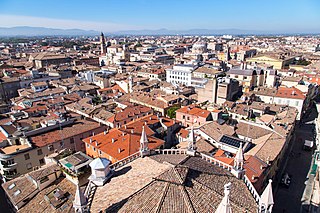Nestled in the northern Italian region of Emilia-Romagna, Parma is renowned for its rich gastronomy, art, and architectural heritage. This city offers an exquisite blend of culinary delights, from its world-famous Parmigiano Reggiano cheese to its refined Parma ham. Visitors can explore a plethora of historic sites, including the Romanesque Parma Cathedral and the octagonal Baptistry made from pink Verona marble. Parma also celebrates a vibrant cultural scene, hosting prestigious events such as the Parma Ham Festival and Verdi Festival, making it a must-visit for those who cherish music, art, and food.
When visiting Parma, be sure to take a guided food tour to discover and savor authentic local flavors like Parmigiano Reggiano and Prosciutto di Parma in their birthplace.
Allocate time to visit Teatro Regio, an iconic opera house in Parma, which hosts a range of performances, particularly during the Verdi Festival, celebrating the famed composer.
Top things to do & see in Parma
Select the following sights and activities to discover best tickets and tours available in Parma.
Parma: A Culinary and Cultural Jewel
| Country | Italy |
| Time in Parma | GMT+1 |
| Language spoken | Italian |
| Population | 198,292 (source: ISTAT) |
| Currency | Euro (€, EUR) |
| Airports |
|
Parma, nestled in the northern region of Italy, is renowned for its vibrant history, rich culture, and exquisite gastronomy. This charming city, one of the oldest in Italy, plays a pivotal role in the culinary landscape, famously known for Parmigiano Reggiano cheese and Parma ham. Historically, it has been a major art and architectural hub, bearing collections from the Renaissance and Romanesque periods, making it a haven for art enthusiasts.
Where is Parma?
Parma is located in the Emilia-Romagna region of Northern Italy, lying between the Po River and the Apennine Mountains.
Distances:
| Route | Distance by car | Time by car |
|---|---|---|
| Milan to Parma | 87 miles (140 km) | 1 hour 30 minutes |
| Bologna to Parma | 60 miles (97 km) | 1 hour |
What is Parma famous for?
Parma is globally celebrated for its culinary products, including Parmesan cheese and Parma ham. It also has a rich operatic and theatrical history, home to the Teatro Regio, an acclaimed opera house that hosts a range of performances.
History
Prehistoric to Roman Times (Before 183 BC)
Parma, located in the northern region of Italy, boasts a rich history that stretches back to prehistoric times. Evidence suggests that the area was inhabited by various tribal groups, eventually conquered by the Romans in 183 BC. This period marked the beginning of Parma’s integration into the vast Roman Empire, significantly influencing its cultural and architectural development.
The Middle Ages (476-1400)
Following the fall of the Roman Empire, Parma endured a period marked by invasions and political turmoil. During the Middle Ages, it became a significant feudal lordship. The city saw the construction of many of its key historical structures, including the Palazzo della Pilotta and the Parma Cathedral. The influence of the church was paramount during this time, greatly impacting the social and economic structure of the city.
Renaissance to the Napoleonic Era (1400-1815)
The Renaissance brought about a cultural flourishing in Parma, visible in its architecture and the arts. Under the patronage of the Farnese family, the city became a hub of artistic and intellectual activity. The period leading up to and including Napoleonic rule saw Parma at the center of European politics, often serving as a pawn in the larger geopolitical games of the time.
Modern Era (1815-Present)
Post-Napoleon, Parma went through a series of political changes, becoming part of the newly unified Kingdom of Italy in 1861. The 20th century was a time of significant growth and modernization, with Parma establishing itself as an important industrial and cultural city in Italy. Today, Parma maintains a blend of historical heritage and modern convenience, making it a fascinating chronicle of Italian history. [/p]
Visit Parma
What to see and do in Parma
Parma is a city rich in culture, history, and gastronomy. Visitors can explore the stunning Parma Cathedral, with its impressive frescoes, and the adjacent Baptistery, a masterpiece of Italian Romanesque architecture. The Palazzo della Pilotta, once a court under the Farnese family, now houses several museums offering a glimpse into the past and present of Parma’s artistic inclinations. For theater enthusiasts, a visit to the Teatro Regio is essential, known for its high-quality opera performances. The city’s parks, like Parco Ducale, offer serene landscapes ideal for leisurely strolls.
- Parma Cathedral
- Teatro Regio
- Palazzo della Pilotta
- Parco Ducale
Festivals and Events in Parma
Parma is bustling with cultural events throughout the year. The highlight is the Parma Ham Festival, typically held in September, which celebrates the world-renowned Prosciutto di Parma. The Verdi Festival, occurring in October, honors the legacy of the composer Giuseppe Verdi, with a series of opera performances and concerts that attract visitors globally.
Best time to visit Parma
The ideal time to visit Parma is during spring (April to June) or early autumn (September to October). These seasons offer mild weather, perfect for enjoying the city’s numerous outdoor activities and vibrant festivals.
Is Parma worth visiting?
Parma undoubtedly merits a visit due to its rich historical tapestry, vibrant cultural scene, and exceptional culinary offerings. Known for its contributions to art, music, and cuisine, Parma provides a unique glimpse into the heritage of northern Italy, making it a valuable addition to any travel itinerary.









